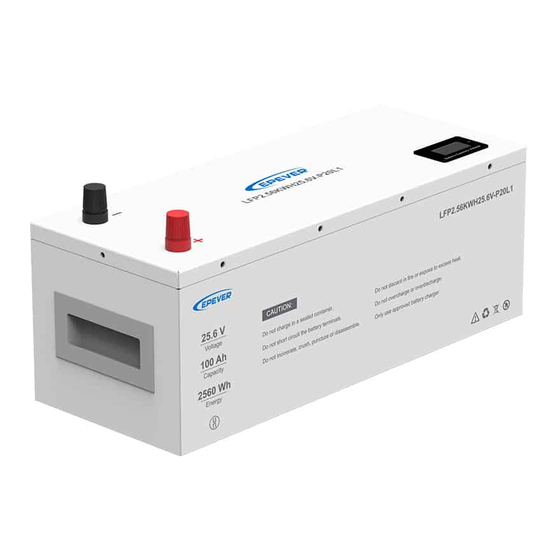
Advertisement
HUIZHOU EPEVER TECHNOLOGY CO., LTD
※ Thanks for selecting the EPEVER LiFePO4 battery; please read this
manual carefully before using the product.
※ Do not use the product in humid, salt spray, corrosion, greasy,
flammable, explosive, dust accumulative, or other severe environments.
※ Please reserve this manual for future review.
LiFePO4 (LFP) Battery
1. Important Safety Instructions
Work and storage precautions:
a) Please store the battery in a cool and dry place. Keep the battery
away from corrosive, explosive, and insulating gases or conductive
dust, as well as away from sources of fire, heat, and high voltage. It is
forbidden to immerse the battery in water and keep children out of
reach of the battery. No static electricity exists (static electricity can
easily damage the battery protection circuit and cause battery
damage).
b) Fix the battery securely in a reasonable environment, and connect the
connector reliably to avoid arcs and sparks caused by the contact
friction.
c) Handle the battery gently to avoid vibration, collision, and pressure
shock. Otherwise, it may cause battery short circuit, resulting in high
temperature and fire.
d) Do not short-circuit the battery, and do not disassemble the battery to
avoid danger.
e) Please keep the battery in a half-charge state (40%~80% SOC is
preferred). Please use non-conductive materials to wrap the battery to
avoid direct contact with metal, which may cause damage to the
battery.
f) Dispose of discarded batteries safely and not put them in fire or liquid.
Hazard warning:
a) It is strictly forbidden to crush, drop, collide, puncture, burn, or other
destructive acts on the battery.
b) Do not disassemble the battery. Improper disassembly may damage
the battery's protection function, causing battery deformation, heating,
smoking, or burning.
c) Do not short-circuit the battery. Connecting the battery's positive and
negative poles with conductive materials, storing and transporting the
battery together with conductive materials are prohibited.
d) Do not heat or burn batteries. Otherwise, it will cause the melting of
battery components, loss of safety functions, or electrolyte
combustion. Overheating can deform the battery, heat, smoke, or
burn.
Emergency treatments:
a) Avoid skin and eye contact with the electrolyte when it leaks. In case
of contact, immediately wash with plenty of water and seek help from
a doctor. It is forbidden for any person or animal to swallow any part of
the battery or the substances contained in the battery.
LFP2.56KWH25.6V-P20L1
1
TEL: +86-752-3889706
2. Appearance
❶
❷
❹
3. LCD
No.
Status
❶
Working
Including: STBY (standby), CHG (charging), DISCH
status
(discharging), and ERROR.
❷
Data
Display the battery current voltage, current, and
display
temperature.
❸
Including: OC (over current protection), CHG
Protectio
(charging protection), DISCH (discharging
ns
protection), and TEMP (temperature protection)
❹
SOC
Display the actual SOC percentage.
value
❺
Display the SOC by cell, one cell indicates the SOC
SOC icon
is 25%.
❻
Short press the power button to light up the screen.
Power
After 30 seconds, the screen goes off and enters the
button
energy-saving mode.
4. Charging Operation
1. General Checking.
Check thoroughly including all the cables for showing no damages.
Make sure the mains supply complies with the specification of the
charger and the battery.
2. Turn off the charger and connect it to the battery.
WARNING: Check the battery polarity before connecting to the
charger. It is forbidden to reverse connect the battery.
3. Connect the charger to mains supply and turn on the charger.
4. Press the LCD power button once, and the LCD shows "CHG" to start the
charging process.
Standard charge:
First, charge the battery to 28.8V with a constant current of 20A (0.2C), and
then charge to 0.05C with a constant voltage of 28.8V (i.e. 0.05C means
0.05 x battery capacity).
Note: All tests stated in this document shall be performed at 25±2℃.
2
Website: www.epever.com
❸
❶ Battery negative terminal
❷ Battery positive terminal
❸ LCD
❹ Handle
Instruction
Advertisement
Table of Contents

Summary of Contents for Epever LFP2.56KWH25.6V-P20L1
- Page 1 TEL: +86-752-3889706 Website: www.epever.com 2. Appearance ❸ ※ Thanks for selecting the EPEVER LiFePO4 battery; please read this manual carefully before using the product. ❶ Battery negative terminal ※ Do not use the product in humid, salt spray, corrosion, greasy, ❶...
- Page 2 HUIZHOU EPEVER TECHNOLOGY CO., LTD TEL: +86-752-3889706 Website: www.epever.com 8. Specifications 5. Discharging Operation Model LFP2.56KWH25.6V-P20L1 1. Before discharging, ensure the load and equipment are in the off state. Battery Type LiFePO4 2. Connect the battery to the load and equipment correctly.





Need help?
Do you have a question about the LFP2.56KWH25.6V-P20L1 and is the answer not in the manual?
Questions and answers